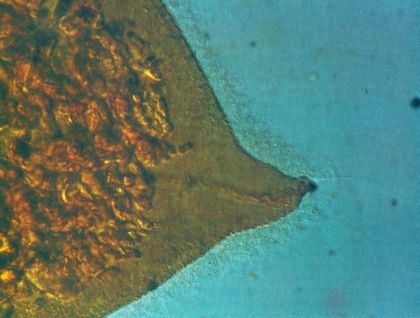
Microscopic photo of the fermentation chamber-flagellate
Mixotricha paradoxa. The wood pieces are clearly visible
within the cell. Four flagella are weakly visible at the apex.
|
Mixotricha paradoxa is one of the largest flagellates within the fermentation chamber. It can be found in the Darwin-termite Mastotermes darwiniensis in northern Australia. The ciliate belongs to the archaic group of archaeozoa. It has four quite weak flagella, which only serve as a rudder. The real locomotion, even it is very sedate, is caused by symbiotic bacteria strongly attached on the surface of the protistan cell. They are visible as a fine egde at the left side of the picture.
So far, this kind of movement-symbiosis between eukaryots and procaryots is unique.
|